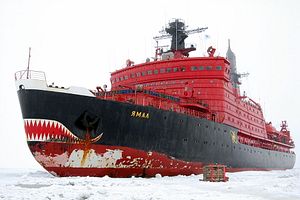Russia is expected to commission the lead ship of its new class of nuclear-powered icebreakers in 2019, according to a senior Russian official.
With a length of 173 meters and a width of 34 meters, the 33,000-ton LK-60YA-class icebreaker Arktika will be the world’s largest icebreaking vessel and a testimony to Russia’s growing ambitions in the Arctic region.
“The Arktika will be the flagship in the Russian nuclear icebreaker fleet. The ship will be equipped with a RITM-200 nuclear propulsion plant, which comprises two reactors of 175 MW each,” Vyacheslav V. Ruksha, the head of Atomflot, the Russian state-owned company that maintains the world’s only fleet of nuclear-powered icebreakers, said in an email interview with Russian media.
The ship was launched in June 2016. The remaining two vessels of the class were reportedly already laid down and are expected to be commissioned in 2019 and 2020 respectively. June 2016, also saw the launch of the 6,000-ton Project 21180 diesel-electric icebreaker Ilya Muromets, Russia’s first new military icebreaker in half a century. The ship will be commissioned this year, but Ruksha is adamant that Russia’s position in the Arctic depends will primarily depends on its fleet of nuclear-powered icebreakers.
“The nuclear plant on the ship consumes only a few tons of nuclear fuel a day. In comparison, a piston engined sip would require tens of tons of oil for that task. That is why diesel-powered icebreakers are essentially unable to ensure year-round navigation in the Arctic region,” he said.
The principal task for the new class of nuclear-powered icebreakers will be to clear passages for ship traffic on the Northern Sea route, which runs along the Russian Arctic coast from the Kara Sea to the Bering Strait.
The head of Atomflot expects an increase in ship traffic along this route. “It may reach up to 30 million tons per annum. To make this cargo traffic possible, Russia is building the world’s largest nuclear-powered icebreakers,” Ruksha said. (In 2016, cargo along the route was 6.5 million tons.)
“In the coming decades, our main task will be to provide icebreaker support for the national hydrocarbon projects with direct transportation to Pacific Ocean markets,” he added.
Russia currently operates 40 icebreakers. It intends to commission over a dozen additional vessels in the years ahead. The United States currently has two icebreakers, only one of which is a heavy icebreaker capable of year-round operation in the Arctic. As I reported last week, the U.S. Coast Guard has recently awarded five firm fixed-price contracts for heavy polar icebreaker design studies and analysis for the United States’ new class of icebreaking vessels.
































